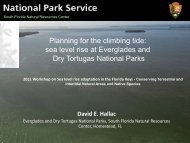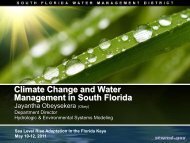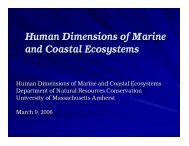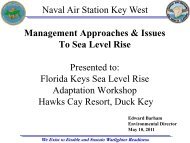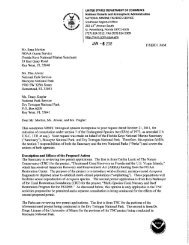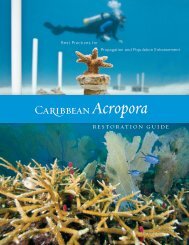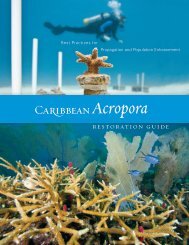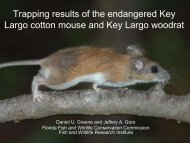Lower Keys marsh rabbit (a.k.a. LKMR) ⦠and its place near the sea ...
Lower Keys marsh rabbit (a.k.a. LKMR) ⦠and its place near the sea ...
Lower Keys marsh rabbit (a.k.a. LKMR) ⦠and its place near the sea ...
Create successful ePaper yourself
Turn your PDF publications into a flip-book with our unique Google optimized e-Paper software.
Florida <strong>Keys</strong> National Wildlife Refuge Complex<br />
<strong>Lower</strong> <strong>Keys</strong> <strong>marsh</strong> <strong>rabbit</strong><br />
(a.k.a. <strong>LKMR</strong>)<br />
… <strong>and</strong> <strong>its</strong> <strong>place</strong> <strong>near</strong> <strong>the</strong> <strong>sea</strong><br />
… <strong>and</strong> <strong>its</strong> neighbor <strong>the</strong> silver rice rat,<br />
even <strong>near</strong>er to <strong>the</strong> <strong>sea</strong><br />
Phillip Hughes<br />
1
Taxonomy<br />
Sylvilagus palustris hefneri, (A)<br />
S. p. paludicola, (B)<br />
S. p. palustris, (C)<br />
2
Range<br />
3
Overall distribution<br />
4
BPK subpopulation<br />
5
Boca Chica subpopulation<br />
6
Sugarloaf-Saddlebunch subpopulation<br />
7
Birth…dispersal…survival<br />
8
Birth…dispersal…survival<br />
9
Imagery-cover type approach for<br />
delineation of potential habitat<br />
11
Range<br />
12
The “range”; why is<br />
mapping it so important?<br />
• Protections / regulatory reasons<br />
• Monitoring in a probabilistic manner, <strong>and</strong><br />
adaptive management, including<br />
possibilities for optimization<br />
• Quantifying habitat/components<br />
• The latter 2 both important for <strong>sea</strong> level<br />
considerations as well as fire <strong>and</strong> IPM assessment /<br />
prediction<br />
13
Corridor? „O<strong>the</strong>r‟ Habitat?<br />
14
Two environments<br />
19
Salt <strong>marsh</strong><br />
Freshwater <strong>marsh</strong>
mean salinity (PPT)<br />
elevation<br />
18<br />
16<br />
14<br />
12<br />
10<br />
8<br />
6<br />
4<br />
2<br />
0<br />
Average of salin_ppt<br />
Average of lidar_rast_valu<br />
0.8<br />
0.7<br />
0.6<br />
0.5<br />
0.4<br />
0.3<br />
0.2<br />
0.1<br />
0.0<br />
21
Matrix “surrounding” <strong>the</strong> 2 environments<br />
22
Saltwater-freshwater <strong>marsh</strong> transitions<br />
23
Roads & freshwater<br />
24
Mosquito ditches<br />
25
Mosquito ditches<br />
26
Mosquito ditches<br />
27
Population trends<br />
28
<strong>LKMR</strong> frequency of occurrence<br />
0.9<br />
0.8<br />
0.7<br />
0.6<br />
0.5<br />
0.4<br />
0.3<br />
0.2<br />
0.1<br />
0.0<br />
y = -0.0091x + 18.796<br />
R² = 0.2418<br />
1986 1990 1994 1998 2002 2006 2010<br />
Proportion of patches at which pellets were<br />
detected (rangewide)<br />
29
<strong>LKMR</strong> frequency of occurrence<br />
1.2<br />
BOCHICA BPK SUGAR<br />
1<br />
0.8<br />
0.6<br />
0.4<br />
0.2<br />
0<br />
1985 1990 1995 2000 2005 2010 2015<br />
Proportion of patches at which pellets were<br />
detected, by metapopulation<br />
30
2 environments<br />
1.2<br />
pellet detection (freq.occur.) in patches grouped by<br />
coastal/saltwater vs interior/freshwater<br />
1.0<br />
0.8<br />
0.6<br />
C_ST<br />
I_FR<br />
0.4<br />
0.2<br />
0.0<br />
1975 1980 1985 1990 1995 2000 2005 2010 2015
cams .<br />
32
ARM<br />
33
Decision Problem<br />
• Long-term<br />
sustainability of<br />
<strong>LKMR</strong> in <strong>its</strong> natural<br />
range (using<br />
sociopolitically<br />
acceptable means)
Alternative Actions<br />
• Do nothing<br />
• Burn<br />
• Predator control<br />
• Burn & Predator control<br />
• Mechanical control of overstory<br />
• Brushpiles/artificial structures<br />
• Supplement numbers in occupied habitats<br />
• Reduce road mortality (speed bumps, tunnels, signals)<br />
• Restore habitat (fill in mosquito ditches, plant grasses)<br />
• Translocation to potential suitable habitat<br />
• L<strong>and</strong> acquisition
Objectives<br />
Fundamental Objective:<br />
Ensure <strong>the</strong> long-term viability of <strong>the</strong> <strong>Lower</strong> <strong>Keys</strong> <strong>marsh</strong> <strong>rabbit</strong><br />
throughout <strong>its</strong> natural range by implementing ecologically<br />
appropriate <strong>and</strong> socio-politically acceptable action(s).<br />
Means Objectives:<br />
Reduce predation<br />
Improve habitat<br />
Measurable Attribute:<br />
Maximize <strong>rabbit</strong> patch occupancy rates to within 90% of<br />
historically high occurrence across all potential <strong>rabbit</strong> habitats<br />
on federal l<strong>and</strong>s in <strong>the</strong> National Key Deer Refuge.
Attributes that can be measured<br />
effectively, <strong>and</strong> efficiently<br />
(predation, usually less-so)<br />
Occupancy<br />
State<br />
Habitat State<br />
Fire<br />
Storm Surges<br />
Predation<br />
Predominant factors through<br />
which management can be<br />
influential
Increase<br />
viability<br />
Reduce<br />
predation<br />
Improve<br />
habitat<br />
IPM<br />
Impart<br />
fire<br />
Control<br />
cats<br />
Study<br />
raccoons<br />
Increase<br />
herb.<br />
cover<br />
Increase<br />
patch size<br />
Increase<br />
connectivity
<strong>LKMR</strong> related concerns<br />
salinity<br />
fire<br />
predators<br />
Population<br />
viability
1 - Do nothing = Status quo<br />
Alternatives<br />
2 - Improve habitat = Conduct prescribed burning <strong>and</strong>/or mechanical<br />
control in poor condition habitats on federal l<strong>and</strong>s to remove or thin<br />
overstory <strong>and</strong> encourage herbaceous plants<br />
Model Assumption: Only apply treatment to subset of poor patches<br />
per year due to operational constraints <strong>and</strong> only about 70% of burns<br />
will likely be “successful” (e.g. consistent vs. patchy fuels, burn<br />
conditions, etc.).<br />
3 - Reduce predation = Remove non-native predators (cats) from<br />
federal l<strong>and</strong>s<br />
Model Assumption: Trapping effort is successful in removing large<br />
majority of cats.<br />
4 - Improve habitat & reduce predation = Combination of above
State Transition Model<br />
Current State<br />
Action<br />
a<br />
b<br />
Predicted State<br />
Poor Habitat/<br />
Low Occupancy<br />
Poor Habitat/<br />
High Occupancy<br />
Poor Habitat/<br />
Low Occupancy<br />
Poor Habitat/<br />
High Occupancy<br />
Good Habitat/<br />
Low Occupancy<br />
Good Habitat/<br />
Good Occupancy<br />
c<br />
d<br />
probabilities<br />
(a + b + c + d = 1.0)<br />
Good Habitat/<br />
Low Occupancy<br />
Good Habitat/<br />
Good Occupancy
Trade-offs (Optimization)<br />
2.<br />
1.
Occupancy modeling<br />
In our case – in our overall<br />
framework – occupancy modeling<br />
<strong>and</strong> monitoring are essentially<br />
synonymous
Occupancy model<br />
• The proportion of sites occupied by<br />
<strong>LKMR</strong> is an appropriate state<br />
variable for use in prescribing<br />
management actions (i.e., statedependent<br />
decisions) <strong>and</strong> for<br />
monitoring.<br />
44
Occupancy model<br />
• Occupancy is a central state variable in<br />
meta-population studies, where <strong>the</strong><br />
principal concern is <strong>the</strong> extinction <strong>and</strong><br />
colonization of local sites (patches)<br />
ra<strong>the</strong>r than estimates of abundance or<br />
density (Hanski 1991, Komonen et al.<br />
2008).<br />
45
Occupancy model<br />
• Considerations when using<br />
occupancy as opposed to<br />
abundance should include possible<br />
trade-offs between reduced cost<br />
<strong>and</strong> effort <strong>and</strong> <strong>the</strong> strength of <strong>the</strong><br />
correlation between abundance<br />
<strong>and</strong> area occupied<br />
46
Occupancy model<br />
We considered multiple survey<br />
plots within each patch as<br />
independent spatial replicates<br />
<strong>and</strong> as <strong>the</strong> basis for estimating p.<br />
47
Occupancy model - methods<br />
• The choice of a 12-m diameter plot<br />
reflected a compromise between<br />
• 1) an area small enough to yield high<br />
detection probabilities (given <strong>the</strong> presence<br />
of pellets in <strong>the</strong> plot) for better precision of<br />
occupancy estimates <strong>and</strong><br />
• 2) a large enough area as to have a nonnegligible<br />
probability of containing pellets<br />
(given presence of <strong>rabbit</strong>s in <strong>the</strong> patch).<br />
48
Occupancy model<br />
• Thus far our analyses are limited to<br />
a priori hypo<strong>the</strong>ses of 2 potential<br />
explanatory variables influencing<br />
occupancy <strong>and</strong> detection<br />
probability: 1) patch location with<br />
respect to coastal or inl<strong>and</strong><br />
vegetation communities <strong>and</strong> 2)<br />
patch area<br />
49
Probability of Occupancy<br />
0.2 0.4 0.6 0.8 1.0<br />
Coastal patches<br />
0 10 20 30 40 50<br />
Patch size (Ha)<br />
Predicted probability of <strong>Lower</strong> <strong>Keys</strong> <strong>marsh</strong> <strong>rabbit</strong> occupancy at<br />
coastal sites, conditioned on habitat patch size<br />
50
Occupancy model<br />
• This approach allows conservation<br />
efforts to be more targeted,<br />
focusing on those factors <strong>and</strong> vital<br />
rates (e.g., demographic rates of<br />
colonization <strong>and</strong> extinction) having<br />
<strong>the</strong> greatest impact relative to<br />
management goals<br />
51
Occupancy model<br />
• <strong>LKMR</strong> is not unique in <strong>the</strong> sense that ~25%<br />
of all <strong>rabbit</strong>s, hares, <strong>and</strong> pikas are threatened<br />
with extinction (<strong>and</strong> more declining, “of<br />
course”) [see Smith 2008].<br />
• The study design <strong>and</strong> analytical approach<br />
used here can allow for quantification of<br />
detection probability when estimating<br />
distribution or occupancy, <strong>and</strong> may be<br />
appropriate for many lagomorphs <strong>and</strong> o<strong>the</strong>r<br />
cryptic species inhabiting diverse or dynamic<br />
habitats.<br />
52
Acknowledgements<br />
Special thanks to<br />
Ka<strong>the</strong>rine Perry<br />
53
Acknowledgements<br />
• U.S.F.W.S. – Anne Morkill, Kristie Killam,<br />
Joshua Albritton, Chad Anderson; numerous<br />
SFESO staff <strong>and</strong> previous NKDR staff/<br />
associates plus folks at RO <strong>and</strong> beyond<br />
• U.S.G.S. Patuxent – James Nichols, Mitch<br />
Eaton, Allan O’Connell <strong>and</strong> o<strong>the</strong>rs<br />
• Naval Air Station Key West – Rod Flemming,<br />
Carrie Backlund, Ed Barham <strong>and</strong> many o<strong>the</strong>rs<br />
• Elizabeth A. Forys, Eckerd College<br />
• Texas A&M University – Nova Silvy, Roel<br />
Lopez; Craig Faulhaber, Jason Schmidt <strong>and</strong><br />
many o<strong>the</strong>r students/interns<br />
• U. Central Florida – Eric Hoffman, Rosanna<br />
Tursi, James D. Roth, Mat<strong>the</strong>w Gordon <strong>and</strong><br />
o<strong>the</strong>rs<br />
54
Acknowledgements<br />
• Joseph O’brien, U.S.F.S., Sou<strong>the</strong>rn<br />
Re<strong>sea</strong>rch Station<br />
• John Litvaitis, U. New Hampshire<br />
55



